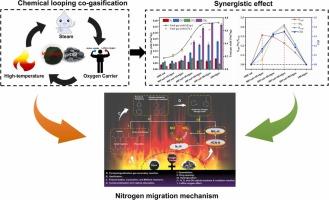Targeted migration mechanisms of nitrogen-containing pollutants during chemical looping co-gasification of coal and microalgae
IF 12.2
1区 环境科学与生态学
Q1 ENGINEERING, ENVIRONMENTAL
引用次数: 0
Abstract
The chemical looping co-gasification of nitrogen-containing algal biomass and coal could effectively realize the high-value utilization of gasification products, but the mechanism of conversion of nitrogen-containing pollutants is not clear. In this work, the effects of the different ratios of microalgae on the co-gasification process were first explored, and the results showed that the 40% coal + 60% microalgae blending had the best synergistic effect, with a comprehensive synergistic index (CSI) of 1.35 as the maximum value. The effects of temperature, the ratio of OCs to feed (O/C) and steam flow rate on the evolution of nitrogen-containing species in the co-gasification products were explored based on the optimal mixing ratio, and the results showed that elevating the reaction temperature promotes the generation of nitrogen oxide precursors, and an appropriate amount of steam could inhibit the generation of NOx. The nitrogen in coke mainly came from the Maillard reaction between carbonyl (-C=O) compounds and amino (-NH2) compounds and its main forms are pyridine nitrogen (N-5) and pyrrole nitrogen (N-6). Based on the nitrogen accumulation forms in the products of each phase, the mechanism of nitrogen transport and conversion in the chemical looping co-gasification of coal and microalgae (CM-CLCG) process was proposed. This study provides a reference for the synergistic utilization of coal and biomass and the control process of nitrogen-containing pollutants.Environmental Implication
NOx is a common gaseous pollutant, including a variety of compounds, such as nitrous oxide (N2O), nitric oxide (NO), nitrogen dioxide (NO2), which cause harm to human and environment. The pre-regulation of NOx precursor in the process of chemical chain co-gasification and the collaborative control of NOx emission in the process of reaction are realized in this work by changing the ratio of coal to microalgae and regulating reactive oxygen species and reactive groups in the reaction environment. This study provides a reference for the synergistic utilization of coal and biomass and the control process of nitrogen-containing pollutants.

煤与微藻化学环共气化过程中含氮污染物的定向迁移机制
含氮藻类生物质与煤的化学循环共气化可有效实现气化产物的高值化利用,但含氮污染物的转化机理尚不清楚。本研究首先探讨了不同比例的微藻对协同气化过程的影响,结果表明,40%煤+60%微藻混配的协同效应最好,综合协同指数(CSI)最大值为1.35。在最佳混合比的基础上,探讨了温度、OCs 与进料的比例(O/C)和蒸汽流量对协同气化产物中含氮化合物演化的影响,结果表明,提高反应温度会促进氮氧化物前体的生成,而适量的蒸汽可以抑制氮氧化物的生成。焦炭中的氮主要来自羰基(-C=O)化合物和氨基(-NH2)化合物之间的马氏反应,其主要形式为吡啶氮(N-5)和吡咯氮(N-6)。根据氮在各阶段产物中的积累形式,提出了煤与微藻化学循环协同气化(CM-CLCG)过程中氮的迁移和转化机理。该研究为煤与生物质的协同利用及含氮污染物的控制工艺提供了参考。 环境影响 氮氧化物是一种常见的气态污染物,包括氧化亚氮(N2O)、一氧化氮(NO)、二氧化氮(NO2)等多种化合物,对人类和环境造成危害。本研究通过改变煤与微藻的比例,调节反应环境中的活性氧和活性基团,实现了化学链协同气化过程中氮氧化物前体的预控和反应过程中氮氧化物排放的协同控制。该研究为煤与生物质的协同利用及含氮污染物的控制过程提供了参考。
本文章由计算机程序翻译,如有差异,请以英文原文为准。
求助全文
约1分钟内获得全文
求助全文
来源期刊

Journal of Hazardous Materials
工程技术-工程:环境
CiteScore
25.40
自引率
5.90%
发文量
3059
审稿时长
58 days
期刊介绍:
The Journal of Hazardous Materials serves as a global platform for promoting cutting-edge research in the field of Environmental Science and Engineering. Our publication features a wide range of articles, including full-length research papers, review articles, and perspectives, with the aim of enhancing our understanding of the dangers and risks associated with various materials concerning public health and the environment. It is important to note that the term "environmental contaminants" refers specifically to substances that pose hazardous effects through contamination, while excluding those that do not have such impacts on the environment or human health. Moreover, we emphasize the distinction between wastes and hazardous materials in order to provide further clarity on the scope of the journal. We have a keen interest in exploring specific compounds and microbial agents that have adverse effects on the environment.
 求助内容:
求助内容: 应助结果提醒方式:
应助结果提醒方式:


